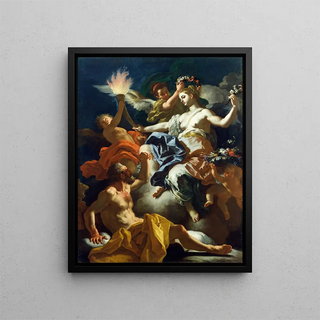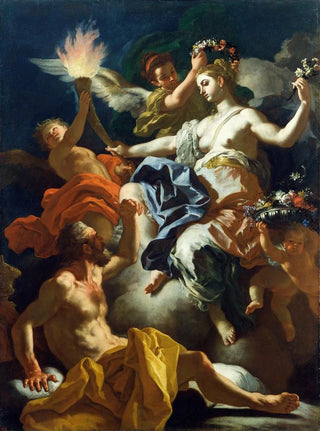Art print | Aurora Taking Leave of Tithonus - Francesco Solimena


View from behind

Frame (optional)
Francesco Solimena’s art print "Aurora taking leave of Tithonus" immerses viewers in a mythological universe where beauty and melancholy intertwine. Created in the 18th century, this painting captures the delicate moment when Aurora, personification of dawn, bids farewell to Tithonus, her lover. Bathed in soft, golden light, it encapsulates the very essence of the passage of time, symbolizing the transition between night and day. Through this work, Solimena invites us to contemplate the fleeting beauty of love and ephemeral moments.
Style and uniqueness of the art print
Solimena’s style is distinguished by its baroque approach, characterized by dynamic compositions and masterful use of light. In "Aurora taking leave of Tithonus," the figures are rendered with fluid grace, their delicate drapery creating an almost choreographic movement. Pastel colors and golden hues enhance the dreamlike atmosphere, while the expressions of the characters convey poignant melancholy. The artist excels in depicting emotions, transforming a mythological scene into a true exploration of human feelings. The composition, well balanced, draws the eye toward the center, where Aurora and Tithonus meet in a final exchange full of emotion. This art print is an ode to the beauty of fragile moments, a universal theme that resonates through the ages.
The artist and his influence
Francesco Solimena, Neapolitan painter of the 18th century, left his mark with a style that combines baroque tradition with a more modern sensibility. Trained in the workshop of Giovanni Battista Ruoppolo, he quickly developed an artistic signature unique to him. His influence extends beyond his time, inspiring many artists who followed. By integrating narrative elements into his compositions, Solimena created works that tell stories while captivating the viewer. "Aurora taking leave of Tithonus" is a perfect example of this ability to fuse storytelling and aesthetics, offering a visual experience

Matte finish

View from behind

Frame (optional)
Francesco Solimena’s art print "Aurora taking leave of Tithonus" immerses viewers in a mythological universe where beauty and melancholy intertwine. Created in the 18th century, this painting captures the delicate moment when Aurora, personification of dawn, bids farewell to Tithonus, her lover. Bathed in soft, golden light, it encapsulates the very essence of the passage of time, symbolizing the transition between night and day. Through this work, Solimena invites us to contemplate the fleeting beauty of love and ephemeral moments.
Style and uniqueness of the art print
Solimena’s style is distinguished by its baroque approach, characterized by dynamic compositions and masterful use of light. In "Aurora taking leave of Tithonus," the figures are rendered with fluid grace, their delicate drapery creating an almost choreographic movement. Pastel colors and golden hues enhance the dreamlike atmosphere, while the expressions of the characters convey poignant melancholy. The artist excels in depicting emotions, transforming a mythological scene into a true exploration of human feelings. The composition, well balanced, draws the eye toward the center, where Aurora and Tithonus meet in a final exchange full of emotion. This art print is an ode to the beauty of fragile moments, a universal theme that resonates through the ages.
The artist and his influence
Francesco Solimena, Neapolitan painter of the 18th century, left his mark with a style that combines baroque tradition with a more modern sensibility. Trained in the workshop of Giovanni Battista Ruoppolo, he quickly developed an artistic signature unique to him. His influence extends beyond his time, inspiring many artists who followed. By integrating narrative elements into his compositions, Solimena created works that tell stories while captivating the viewer. "Aurora taking leave of Tithonus" is a perfect example of this ability to fuse storytelling and aesthetics, offering a visual experience






